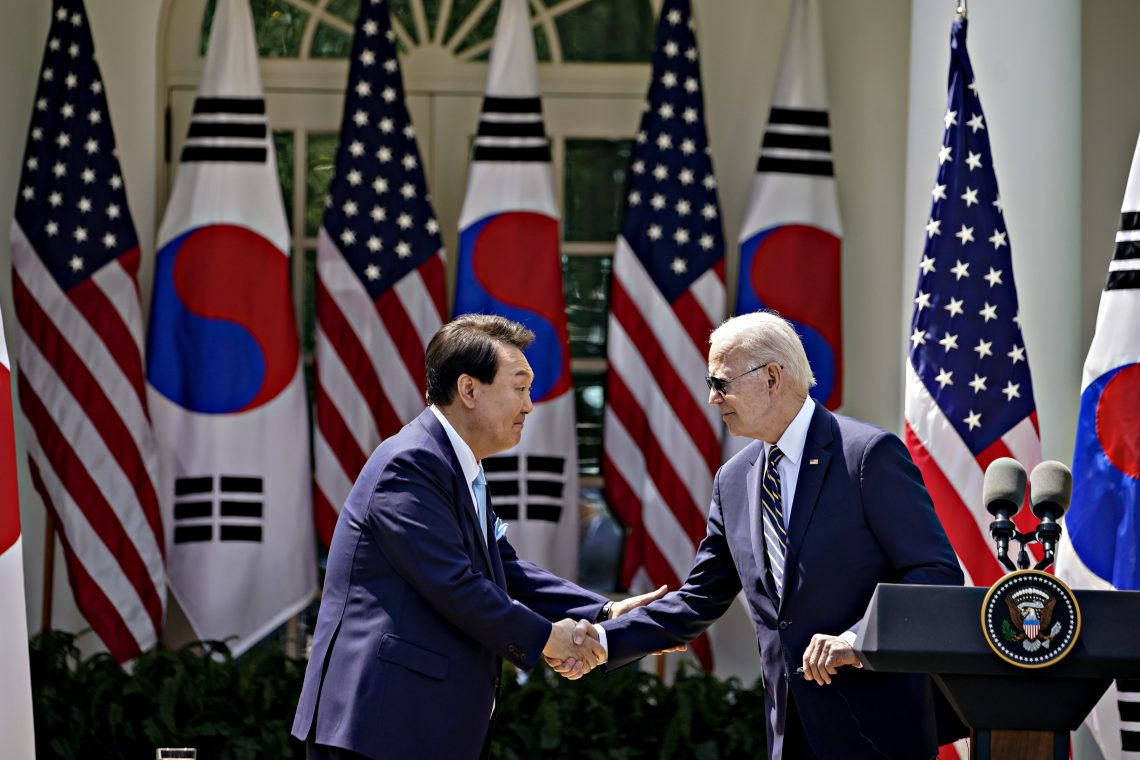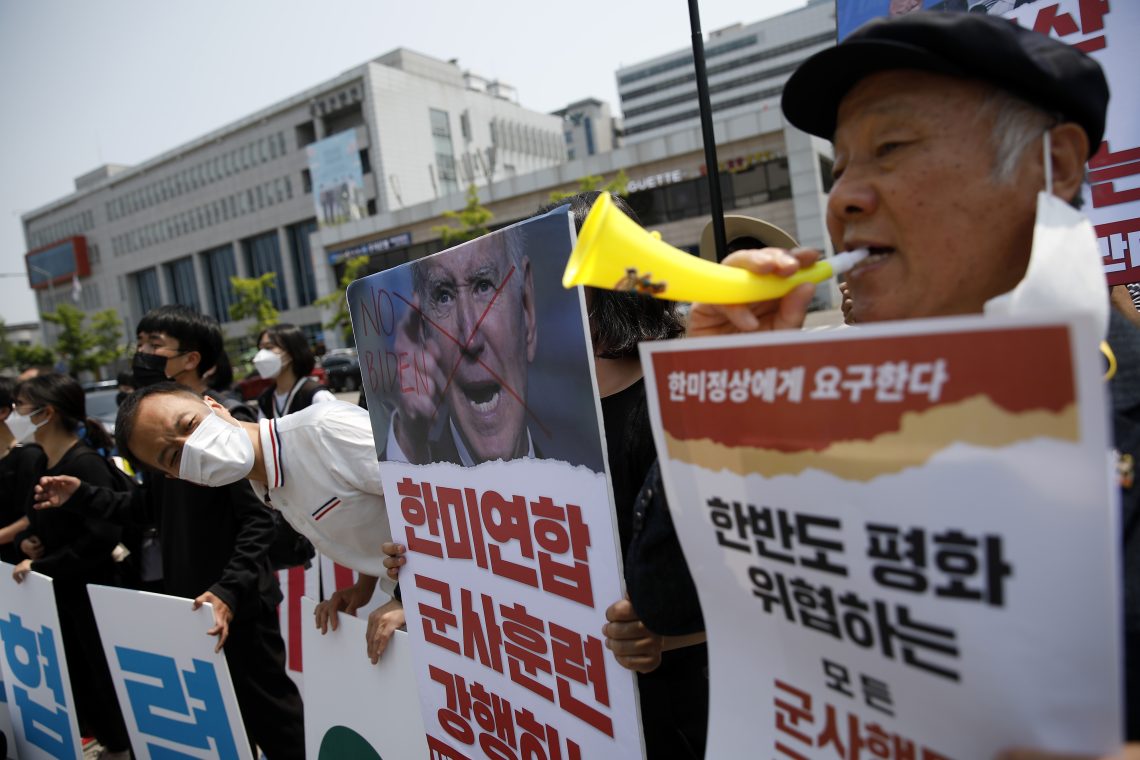The U.S.-South Korea alliance navigates new political terrain
Washington and Seoul continue to have shared interests that will strengthen the bilateral relationship, despite external and internal pressures.

In a nutshell
- The U.S. and South Korea share interests in stronger ties
- Mutual concerns exist over China, Russia
- Victories by opposition parties would not shake the alliance
This year marks the 70th anniversary of the alliance between South Korea (officially the Republic of Korea) and the United States, which dates to the Korean War (1950-1953). The partnership’s future is now shaped by contemporary geopolitics and domestic politics. The prospects for improving, strengthening and expanding ties in the near term are positive, as both governments have elevated the importance of the bilateral relationship.
Domestic politics
Both the U.S. and South Korea today are evenly divided polities, with major political parties generally defined by their opposing views on most key issues. That poses challenges for the two governments, as each faces pressure to show that the bilateral relationship is achieving real results.
On the surface, the two governments could not appear more different. Yoon Suk-yeol is the most conservative South Korean president in recent history, while Joe Biden has championed liberal causes more forcefully than any U.S. president in recent decades.
In South Korea, however, the North Korean nuclear threat remains the top national security concern. Instead of offering conciliatory gestures in response to recent threats and missile tests by Pyongyang, Mr. Yoon has focused on deterrence. For that, he needs a strong and proactive partner in the White House.
Russia’s war against Ukraine – and China’s support for Moscow and its intensifying threats to Taiwan – have also become key concerns for Seoul. In addition, as in other countries, South Korea is increasingly worried about political pressure and interference from Beijing, such as China’s protests over the deployment of the U.S.-made Terminal High Altitude Area Defense (THAAD) system to shield South Korea from the North’s missiles. Seoul frets that Chinese actions could impact peace and stability in Northeast Asia.
It will be hard for Seoul to opt for stronger responses to Beijing without more support from the U.S. and commensurate benefits.
The government in Seoul has also sought to improve its often-troubled relations with Tokyo. Dealing with historical tensions between Japan and South Korea has been a volatile domestic issue. President Yoon, however, sees better ties with Japan as a way to strengthen South Korea’s geopolitical stature in the region and become a more valuable ally for the U.S., which has traditionally sought to improve coordination between the three countries.
President Biden, for his part, is preparing for national elections in 2024. As much as possible, the administration would like to delay dealing with the most contentious and thorny international challenges until after the race. Recently, the Biden team quietly engaged in talks toward an informal, interim nuclear deal with Iran, hoping to forestall the threat of a nuclear breakout or a preemptive attack by Israel in the near term.
Secretary of State Antony Blinken was dispatched to Beijing in a high-profile visit to demonstrate that the China issue can be “managed.” Similarly, the White House hopes that a supportive Korean ally working with China can help tamp down the potential for any North Korean crisis soon.
In short, better ties would benefit both governments, domestically and geopolitically.

Hot-button issues
Despite the positive state of relations, several issues of concern loom over the course of the U.S.-South Korea partnership.
China
There is no consensus in South Korea over how to deal with the challenge of China. On the one hand, there is an impulse to avoid antagonizing Beijing. While South Korea’s trade deficit with China is growing, exports are significant (though they experienced a double-digit decline in 2022). On the other, Seoul is increasingly wary of pressure from Beijing and frustrated that China has done little to help restrain North Korea. The more the government does to strengthen ties with the U.S. and Japan, the more Beijing signals its displeasure with Seoul. Meanwhile, the opposition continues to argue that antagonizing China risks South Korean interests for the benefit of Washington and Tokyo.
The government officially says it seeks a balanced relationship with Beijing. But it is unclear whether that policy remains sustainable. South Korea now finds the Biden administration’s policies somewhat ambivalent. With Secretary Blinken’s visit to Beijing, President Biden showed he is also willing (at least in the short term) to pull punches in dealing with China. It will be hard for Seoul to opt for stronger responses to Beijing without more support from the U.S. and commensurate benefits.
China recently banned importing chips from the U.S.-owned company Micron. The logical alternative suppliers are South Korean companies, but the White House is pressing Korea not to sell to China. If the government in Seoul cannot deliver “win-win” solutions that secure better outcomes for South Koreans, these could be troubling issues in the next election.
Deterrence
With the expansion of China’s nuclear arsenal and North Korea’s growing capabilities to attack South Korea, Japan and the U.S., Seoul is increasingly concerned over whether the American nuclear umbrella – extended deterrence – will remain viable over the long term. This issue flared recently when South Korea raised the possibility of getting its nuclear weapons. The debate was somewhat curtailed when South Korea requested, with U.S. agreement, to establish the Nuclear Consultative Group. In the longer term, what makes extended deterrence viable is not tactical nuclear warheads, but strong, conventional deterrence paired with a robust, modernized nuclear deterrent and missile defense. South Korea will be seeking assurances on both elements.
Supply chains
There is great interest in diversifying supply chains and making them more resilient and less dependent on China. But again, there is no consensus – and lots of uncertainty from the U.S. The dispute over Micron is a good example of the complexity of “de-risking” supply chains, which is the stated goal of both the American and South Korean governments.
Opposition forces
Perhaps the most significant factor restraining more full-throated, bipartisan U.S.-South Korea cooperation is concern over the domestic politics in both countries, where there are fears that the opposition party coming to power could bring radically different policies.
On both sides of the alliance, these fears are, in fact, overblown, fueled by excessive partisan rhetoric. A Republican president is unlikely to restructure the American security relationship with South Korea dramatically. U.S. commitments have been remarkably consistent through the last four presidencies, all very different leaders from two opposing parties. Beyond hyper-partisan language, little suggests that a future Republican president would be an isolationist. Further, both Democrats and Republicans suggest doing more in Asia to meet the challenge posed by China, and abandoning the Korean ally would completely undermine that objective.
Indeed, an opposition-led government in South Korea could adopt softer policies on China and the North and be more skeptical of relations with Washington and Tokyo. Still, the U.S.-South Korean alliance is foundational to South Korean national security, and no major political party argues otherwise.
Scenarios
The most likely scenario in the near term is stable U.S.-Korean relations and continuing improvement in the U.S.-South Korea-Japan partnership. A major trilateral meeting in Washington should be expected this summer. Areas of possible additional cooperation include space activity and exploration, reconstruction and security assistance for Ukraine, development of green energy technology and nuclear power and public health initiatives. The American and South Korean governments will likely seek to accelerate cooperation before their next respective national elections, hoping to lock in progress preemptively.
North Korea’s response will be to engage independently with the U.S., South Korea and Japan, seeking to divide them. In particular, Pyongyang will try to talk directly with Tokyo toward that end; this will likely fail. North Korea can be expected to continue a program of managed antagonism, including a potential nuclear test.
China will likely alternate between “wolf warrior diplomacy,” engagement, and attempts to influence domestic South Korean politics – looking for ways to derail cooperation with the U.S. and Japan and the country’s efforts to decrease its dependence on the Chinese economy.
Meanwhile, the South Korean government will likely supplement its engagement with the U.S. and Japan with like-minded efforts to engage globally in the Indo-Pacific, the Middle East, Europe and Central Asia.








